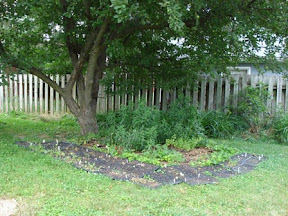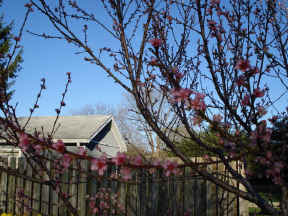I've spent 2 years preparing the soil and last week I finally got to plant! I took all the wildflower seeds and mixed them up in the garden cart with a mixture of peat, perlite and the dregs of potting soil bags, moistened well and stirred thoroughly. I broadcast the seeds by hand and then overseeded with three kinds of native grasses.
Prairie dropseed (Sporobolus heterolepsis) went along one edge. It was the most expensive and makes fairly low growing mounds so I wanted to show it off.
Side oats grama (Bouteloua curtipendula) is the tallest so went in a patch at the back as viewed from the house.
Little bluestem (Schizachyrium scoparium) covered the rest of the bed.
I've read that most of these plants will spend their first year growing deep roots and that it won't look like much above the soil surface. I will post photos as things sprout.
Tuesday, December 18, 2007
Tuesday, November 20, 2007
Wildflower meadow
I spent the weekend doing a final weeding of the prospective wildflower meadow. All the yard waste has composted down to a couple of inches and now that it's raked out it looks like brown velveteen. The seeds have either arrived or are on their way and in a few more weeks when it looks like the weather will stay cold I will sow the forbs and grasses.
Things I will plant next spring
- 3 more Sunshine Blue blueberries to replace the ones that got trampled.
- A couple more southern highbush blueberries to keep in reserve.
- Rosa alba maxima to be planted as a neighbor for Souvenir du Docteur Jamain
- Rose 'Safari', a tiny thing from Heirloom that is a gorgeous pinky, salmony color.
- A dozen Dodecatheon meadia, Shooting Star, ordered bare root from Prairie Moon, to be planted in front of the oakleaf hydrangeas with the Virginia bluebells.
- Magnolia virginiana ‘Moonglow’, a sweet bay magnolia. This will go in the front yard in the space that became plantable after my neighbor removed the dying maple tree.
- Aesculus pavia, red buckeye. This will go in Hagen's Woods to replace the redbud that quite mysteriously died.
Autumn projects
The weather finally cooled off, we had a couple of good, soaking rains that softened up the ground and I've finally made some progress on fall chores. The yard looks pretty respectable now.
- The bed along the fence is edged and weeded.
- The sprawling roses are now tethered to the fence.
- The daylilies and irises are planted.
- The pot ghetto under the apple tree has been cleaned up.
- The seedlings and rooted cuttings are outside where they will winter over.
- The 'meadow' is weeded and raked and ready to be sown with wild flowers and native grasses.
- The seedling wildflowers are planted in the 'meadow'.
- The asparagus has been cut back.
- I have started building this year's compost hump.
- The blueberries are weeded and ready to mulch.
- The fig is wrapped in row cover and mulched with a couple of bags of leaves I begged from a neighbor.
- Dug the red twig dogwoods out from under the big pine tree, planted 4 in the back hedge and gave the rest to my neighbor.
Still to do:
- Mulch the blueberries. I'm going to fill in around them so they become an
extension of the mulched edge at the back of the lot. - Shovel up last year's compost hump and see how it did under the burlap
cover - Weed and mulch the main rose bed.
- Once I'm sure the weather will stay cold I will sow the 'meadow'.
- Repair the garden shed roof. The poor shed needs to be replaced but this
should get me through the winter.
Tuesday, September 18, 2007
Cooler temps
This past week we have had a very welcome break in the heat. Nights have been positively chilly and days beautiful. Sunday afternoon I cleaned up one of the foundation beds. I weeded out everything except the violets. I've decided to let them fill in as a ground cover under the shrubs since they are a larval host plant for fritillary butterflies. I saw quite a few investigating the patch while I worked. The back row is planted with fothergilla gardenii. In front of that are some dwarf iteas and dwarf clethra alnifolia. Two of the clethra 'Sixteen Candles' did not make it throught the summer heat. I was able to find 'Hummingbird' locally so planted two of them. I changed my mind yet again about the New Jersey Tea, ceanothus americanus and planted 20 quart sized seedlings as a front row.
All three kinds of shrubs get fuzzy white, fragrant flowers at one time or another during the year. They are supposed to be attractive to butterflies and hummingbirds.
All three kinds of shrubs get fuzzy white, fragrant flowers at one time or another during the year. They are supposed to be attractive to butterflies and hummingbirds.
Wednesday, August 29, 2007
Passionately prolific
I had read that the passion flower vine, passiflora incarnata, is called maypop because it pops up all over the yard. I can attest that this is true and may become a problem. So far the vine swarmed up all over the Carolina silverbell to the point that it was weighing the branches down dangerously. I pulled a bunch of it off the tree and discarded it but there's still plenty left. It has set quite a few blob shaped green fruits. At this unripe stage they have an odd scent, not exactly pleasant or unpleasant. I'll see what they're like when they ripen. I think they're supposed to be popular with squirrels and other critters.
Friday, August 3, 2007
Change of plans
It's so much easier to move plants in my head than with a shovel. I have some New Jersey Tea (Ceanothus americanus) that I was going to plant along the back edge of the wildflower meadow. I've been reading about maintenance and realized that you have to mow the thing each year, probably not a good thing for a shrub like the NJ tea. I think that instead I will move the too tall redtwig dogwoods out from under the pine tree in the front yard and replace it with the 2 foot tall NJ tea and keep woody plants out of the meadow.
This is both a host and nectar plant for butterflies. It also attracts insects that hummingbirds need to supplement their nectar diet.
This is both a host and nectar plant for butterflies. It also attracts insects that hummingbirds need to supplement their nectar diet.
New daylilies
I am not entirely pleased with my daylily border. There are too many that are the approximate color of a school bus when I prefer clear yellows and peachy colored ones. I'm sure I used to have some of the spider formed ones but they seem not to have made the move from the old house. I found a vendor with amazingly reasonable prices on daylilies and placed an order. I've requested that they hold the shipment until September when the weather cools a bit. Maybe these aren't the latest and hottest varieties but they are pretty colors and think they will improve the border.
http://www.alldaylilies.com/daylilies.htm
http://www.alldaylilies.com/daylilies.htm
Monday, July 16, 2007
Redbud, RIP
Several of us on my street had nice specimens of the redbud cultivar 'Forest Pansy', the one whose leaves hold a deep red color all season long. For no reason anyone could guess Jackie's tree failed to bloom or leaf out this spring and was finally pronounced past help. I looked out last week and saw that mine had turned completely
Virginia soil
Every one of my acid loving plants has started to turn yellow, a condition called chlorosis that usually means the soil is not acid enough to allow them to absorb iron. I had applied HollyTone and sulfur to the base of each earlier in the season but my next door neighbor pointed out that the roots have probably spread out further and the feeder roots are hitting our limestone soil. I've scratched the mulch away and applied the same mix at the drip line and watered it in. I hope that's the only problem. My native azaleas, mountain laurels and blueberries are all affected.
8/07/2007 Update:
I think this is working. At least some of the plants are starting to green up again!
8/07/2007 Update:
I think this is working. At least some of the plants are starting to green up again!
Passion flower
This is a new thing for me. It's Passiflora incarnata, called Maypop because its habit is to die to the ground in the winter and then pop up all over the place in May. I planted it last year and it performed as promised. It's growing up through the branches of a Carolina silverbell (Halesia tetraptera). Here are the first flowers I've seen. It is caterpillar food for Zebra Longwing and Variegated and Gulf Frittilary butterfly larvae.
Viburnum berries ripening
Friday, July 13, 2007
Planting a prairie
I'm nursing my trays of seedling prairie plants, trying to get them through the summer heat until I can plant them out in September. I will then fill in with seeds of native grasses and forbs. When I started the project I knew that it was going to take at least a full year to establish the bed and get the weeds under good control. I hoped to get a good start by planting seeds in trays and overwintering them since many need cold to germinate and spend most of their first year growing a root system. I have some good sized plants blooming from the first winter and trays of very insignificant looking seedlings from this past winter. I'll plant them out but on the whole, I think I invested a lot more time and effort than the result justified. I learned some things along the way but if I had it to do over, would probably just wait until the bed was ready and sow seeds directly.
Some problems I encountered:
My temporary cold frames were constructed from half inch PVC pipe covered with plastic sheeting. The hoops had a rather flattened profile that let snow and water collect and collapse the whole thing. More than once I was out in the sleet cleaning them off.
Then I left the covers on too long and I think it got too hot. Many seedlings fried and died.
The cats thought the cold frames made a cozy place for a springtime nap. Having large hairy beasts lying on them didn't do the seedlings any good either.
Summer doldrums
The daylilies are starting to make a nice splash of color along the fence.
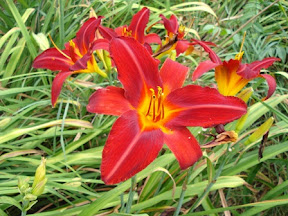

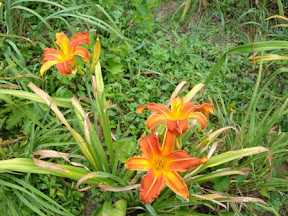
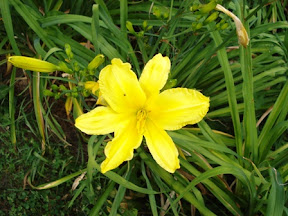
Hot and dry. Virginia in the summer is hot and dry. The roses look sort of discouraged, the weeds have taken over the blueberry bed. I will spend the weekend weeding and watering.
My sister sent me home from Cape Cod with a rose and some irises that were not doing well in a shady bed. The rose is Mountbatten, sold by Heirloom as Lord Mountbatten. I had one that died so am glad to have a replacement. I'll nurse it along in a pot until the weather cools a bit in September. It's a lovely thing, full yellow flowers with the edges of the petals just touched with pink.
Hot and dry. Virginia in the summer is hot and dry. The roses look sort of discouraged, the weeds have taken over the blueberry bed. I will spend the weekend weeding and watering.
My sister sent me home from Cape Cod with a rose and some irises that were not doing well in a shady bed. The rose is Mountbatten, sold by Heirloom as Lord Mountbatten. I had one that died so am glad to have a replacement. I'll nurse it along in a pot until the weather cools a bit in September. It's a lovely thing, full yellow flowers with the edges of the petals just touched with pink.
Wednesday, June 27, 2007
Coral Honeysuckle (Lonicera sempervirens)
This is a native, not the invasive Japanese honeysuckle. It is not fragrant but is supposed to be a magnet for hummingbirds. I've not seen any hummers near it but I only saw them for about a week this spring even around their nectar feeder.
Coral honeysuckle comes in shades from deep red to clear yellow and I have three different cultivars at the back of my lot, behind the asparagus bed and scrambling up over the winterberry bushes.
Hedge roses in late June
The wild roses, R. virginiana and R. carolina have already set hips. They'll be a food source for birds and squirrels in the fall. They're supposed to be edible by humans too but all processing instructions sound like a lot of work.
Darlow's Enigma, a 'found rose' and thought to be a hybrid musk, is still in full bloom. It puts forth flushes of white single flowers all summer long and is very fragrant.
Pimping for my plants
Success is sweet. The cranberry bush viburnums (V. trilobum) have set tons of fruit which is just beginning to redden. Lots of the shrubs I have planted are supposed to bear fruit for the birds. The hitch is, many of them are not self-fertile and have special needs for sex partners. Some require a male and female shrub. Others simply need a second, genetically different member of their own kind. All must actually have overlapping bloom times with their pollinators. The Forest Farm catalog has an excellent chart showing workable alliances for winterberry hollies. The GardenWeb shrub forum has treatises on pairings of viburnums. I had to procure mates and perform the introductions.
Do order yourself a hard copy of Forest Farm's catalog. Even if you never buy from them it's a good reference tool.
Thursday, June 21, 2007
Blueberries!
I have now eaten two ripe blueberries off of my very own bushes. I have about a dozen bushes, none over 2 feet tall yet. They are southern highbush blueberries which I believe are a hybrid between northern highbush and the southern rabbit eye ones. They are supposed to be well adapted to the mid-Atlantic region. You do need several cultivars for cross pollination and overlapping bloom time. They are available from a number of nurseries. I think I have purchased them from Stark Bros. and Park among other places.
I lost almost all of the first ones I planted to hungry rabbits. I don't mean just the berries, the wretched creatures ate the whole plant right to the ground. This winter I surrounded each with its own little chicken wire fence and they seem to be thriving. There must be half a dozen cultivars back there and this one had lost its tag but the berry was large and sweet.
Wednesday, June 20, 2007
Pawpaw (Asimina triloba)
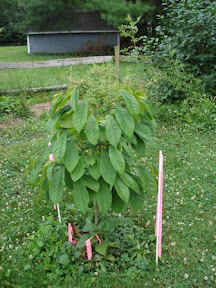
This is the larger of my two pawpaw trees. I planted it two years ago and purchased it from Peterson Pawpaws in West Virginia. It started to bloom this year but a late frost blasted the small purplish flowers. My mom grew up eating pawpaws and did not speak well of them. I've read that seed grown pawpaws are quite variable in flavor, as are apples. Some growers have been identifying particularly tasty ones and then selling grafted plants.
Larger trees get a nice pyramidal shape and I like the long droopy leaves.
This is the main larval host plant for the Zebra Swallowtail butterfly.
The Herb Garden
My herbs are in a bed that wraps around the screen porch. Conditions range from Hot and dry at one end to shady and moister as it disappears under the apple tree and around the far side of the porch. I do a lot of cooking and it's very handy to step out of the kitchen and into the herb garden. The lavender is in full bloom, smells wonderful and is visited by many bees. I cut a handful for flowers and added them to a plastic tub full of sugar. I have a recipe for lavender flavored shortbread that I want to try. Tea party anyone?

In the sunny part I have thyme, sage, rosemary, marjoram, oregano, several cultivars of English lavender.
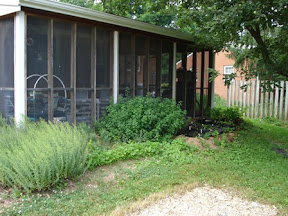
In the shadier part I have lemon balm and then mint and woodruff slugging it out in one bed.
Basil, tarragon and parsley are in the transition zone from sun to shade.
My cats will lounge around in the herbs and may come inside smelling strongly of mint or rosemary. I need to put some catnip out there for them but it's hard to get it established. Cats have no ability to delay gratification and eat the stuff as soon as it sprouts.

In the sunny part I have thyme, sage, rosemary, marjoram, oregano, several cultivars of English lavender.

In the shadier part I have lemon balm and then mint and woodruff slugging it out in one bed.
Basil, tarragon and parsley are in the transition zone from sun to shade.
My cats will lounge around in the herbs and may come inside smelling strongly of mint or rosemary. I need to put some catnip out there for them but it's hard to get it established. Cats have no ability to delay gratification and eat the stuff as soon as it sprouts.
The Impressionist
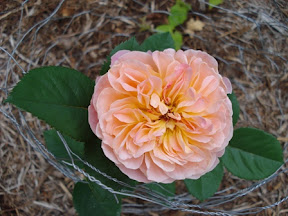 |
| From Roses 2007 |
Thursday, June 14, 2007
Virginia snakeroot (Aristolochia serpentaria)
Pipevine swallowtail butterflies are one of the picky sorts that can only lay their eggs and raise larvae on a very few plants. Aristolochias include the big Dutchman's Pipe vine and the small groundcover Virginia Snakeroot vine. I don't have room for the big Dutchman's Pipe vine and the idea of meeting big black wormy things at eye level is disturbing so I set out to acquire some Virginia snakeroot. Not as easy as you would hope. Through a Garden Web forum I found a man who grows odd woodland plants. His nursery is called Loess Roots but he doesn't seem to have a website. He provided me with a packet of seeds in exchange for keeping records and telling him how I germinated them. I did one batch the winter of 2005 and another in 2006. They need winter chilling to germinate so I did them in flats of a soil and sand mix and got about a 25% germination rate which he said was quite good. The first ones are planted out in the front bed and the second are still in the pots where they wintered over. I didn't think either were going to come up but they are finally emerging and growing. Maybe next year I will get butterflies.
Tuesday, June 12, 2007
Roses
Take a look here for a collection of my 2007 rose photos
http://picasaweb.google.com/susanvhagen/Roses2007
http://picasaweb.google.com/susanvhagen/Roses2007
Wednesday, June 6, 2007
Jack in the pulpit (Arisaema triphyllum)
Saturday, May 26, 2007
Yellowwood blossoms (Cladrastis kentukea)

This was very small when I planted it. You plant them small because they hate having their roots disturbed once they're larger. Since it has made this year's growth it is looking quite satisfyingly substantial. The yellowwood (Cladrastis kentukea) even put out a few blossoms. It doesn't bloom when young and not every year even when mature so I was delighted to see them. They look like creamy white pea blossoms.
Friday, May 25, 2007
Hagen's Woods - Still working on the big project from 2006

On one side of the backyard I have planted a collection of flowering trees and shrubs, all eastern US natives. Trees went in first, a disease-resistant Valley Forge elm, a redbud, two American hollies, a Carolina silverbell and a Yellowwood, the tree shown in the center of the photo.
Several of the new disease resistant flowering dogwoods released by the U. Tennessee dogwood researchers. Appalachian Spring is resistant to anthracnose, the others are resistant to powdery mildew.
Each year I've added shrubs: Serviceberry, scarlet elder, Viburnums trilobum, dentatum and nudum, Spicebush, and Rhododendron atlanticum, arborescens, canescens, periclymenoides, and some hybrids of the native azaleas. I'm about to move some redtwig dogwoods from the front yard where I decided they're too big and straggly for the space.
This gave me a miserable job of mowing in, around and between these individual plants. This year I'm tying them all together into one mulched island. I'm using a year's worth of newspaper and making weekly trips to the liquor store for cardboard. A thick layer of paper goes down first to smother the sod, then mulch over top. It's not quite done but already looking good.
Each year I've added shrubs: Serviceberry, scarlet elder, Viburnums trilobum, dentatum and nudum, Spicebush, and Rhododendron atlanticum, arborescens, canescens, periclymenoides, and some hybrids of the native azaleas. I'm about to move some redtwig dogwoods from the front yard where I decided they're too big and straggly for the space.
This gave me a miserable job of mowing in, around and between these individual plants. This year I'm tying them all together into one mulched island. I'm using a year's worth of newspaper and making weekly trips to the liquor store for cardboard. A thick layer of paper goes down first to smother the sod, then mulch over top. It's not quite done but already looking good.
My efforts to attract wildlife have, in fact, attracted wildlife, mostly in the form of rabbits. Lots of hungry rabbits. I spent a couple of weeks this winter making small chicken wire fences to go around each young tree and shrub since last winter they mostly were eaten to the ground. 12 to 18 inch high rings seems to do the job.
More viburnums
Viburnums in Hagen's Woods

Viburnum trilobum, American cranberrybush
This one has white flowers that look like lacecap hydrangeas. I saw the other day that they have set small green fruit that should ripen and look like hanging cranberries. They're said to be most palatable to birds after they've frozen so are useful for late winter and early spring food.
Tuesday, May 22, 2007
Wildflower meadow - Big project for 2007
Winter of 2005 - 2006 I winter-sowed a lot of forb seeds in flats and got a good germination rate. Some the transplants died during the summer heat but I have quite a few in pots to plant out this spring. I did a lot more this past winter and have about 80 flats of seedlings. I'm not sure when the optimal time to plant will be. Here's the shelter I set up for the seedlings. It's made from the supports that used to be part of raised beds, 1/2 inch pvc pipe form the hoops. It was covered with plastic sheeting this winter and I've replaced that with shade cloth. I've got to work on the design. It is somewhat flattened on the top and that let snow and water accumulate and squash it. I left the plastic on too long and I think some seedlings fried. Either that or the cats squashed them since they decided it made a great place for naps.

For grasses I plan to start with three that are native to this area and supposed to be suitable for the soil and moisture. I don't want the very tallest ones so I have chosen Little bluestem (Schizachyrium scoparium), Prairie dropseed (Sporobolus heterolepsis) and Bottlebrush (Elymus hystrix/Hystrix patula).
In 2006 I laid out a teardrop shaped area that covers approximately 1000 square feet on the left side of the backyard. This is zone 6, full sun, mesic in spring to dry in summer. It's Virginia clay soil and a neighbor enlightened me to why I was hitting a near impenetrable layer about 8 inches down in places – an old railway bed ran through there years back. I killed the grass with glyphosate herbicide and have repeated applications every month or so. Used a broadfork to break up the soil to about 12 inches.

It has received most of last year's compost and fresh yard waste. By happy chance our town changed trash pickup rules and my neighbors brought me grass clippings all season. It looks like I have a good 4 or 5 inches of compost now that it has wintered over. I will need to do a couple of applications of herbicide this spring before I plant. I have some awful perennial weeds to get under control.
I'll plant out all the potted plants and seedling plugs, probably in June. In the fall I will direct sow more grass and wildflower seeds and see what comes up in the spring. I understand it takes about 3 years for it to look like much.

For grasses I plan to start with three that are native to this area and supposed to be suitable for the soil and moisture. I don't want the very tallest ones so I have chosen Little bluestem (Schizachyrium scoparium), Prairie dropseed (Sporobolus heterolepsis) and Bottlebrush (Elymus hystrix/Hystrix patula).
In 2006 I laid out a teardrop shaped area that covers approximately 1000 square feet on the left side of the backyard. This is zone 6, full sun, mesic in spring to dry in summer. It's Virginia clay soil and a neighbor enlightened me to why I was hitting a near impenetrable layer about 8 inches down in places – an old railway bed ran through there years back. I killed the grass with glyphosate herbicide and have repeated applications every month or so. Used a broadfork to break up the soil to about 12 inches.

It has received most of last year's compost and fresh yard waste. By happy chance our town changed trash pickup rules and my neighbors brought me grass clippings all season. It looks like I have a good 4 or 5 inches of compost now that it has wintered over. I will need to do a couple of applications of herbicide this spring before I plant. I have some awful perennial weeds to get under control.
I'll plant out all the potted plants and seedling plugs, probably in June. In the fall I will direct sow more grass and wildflower seeds and see what comes up in the spring. I understand it takes about 3 years for it to look like much.
Tuesday, May 15, 2007
Weeding
Last evening I spent a couple of hours sitting in the front planting bed and weeding out a gazillion maple seedlings from around the shrubs, a mix of mountain laurels and summer blooming native azaleas. I found that the native ground covers I planted last fall made it through the winter and are coming up nicely. There are plenty of wild gingers and goldenseals and I'm pretty sure there are three of the Virginia snakeroots up.


Snakeroot (Aristolochia virginiana)

Goldenseal

Wild Ginger (Asarum canadensis)


Snakeroot (Aristolochia virginiana)

Goldenseal

Wild Ginger (Asarum canadensis)
Mountain Laurel 'Snowdrift'
Tuesday, May 1, 2007
Spring ephemerals in the front yard
Thursday, April 5, 2007
Peach blossoms
Sunday, April 1, 2007
Daffodils along the fence

Last year I got up the nerve to ask my neighbor if I could remove the Japanese honeysuckle rooted on his side of the fence that was a constant maintenance headache on mine. We reached an accord and I removed a mass the size of a queen sized mattress. I've now got climbing roses planted here and there along the border. The first show here is a mass of daffodils.
Subscribe to:
Posts (Atom)




